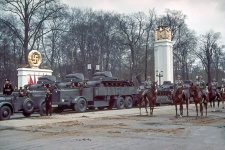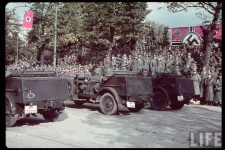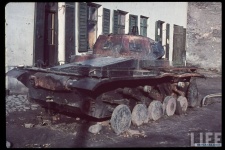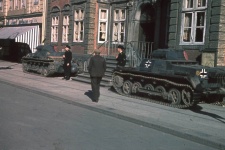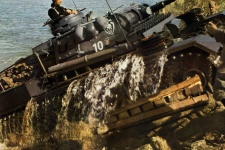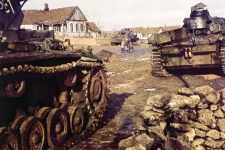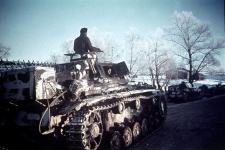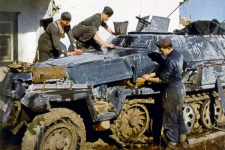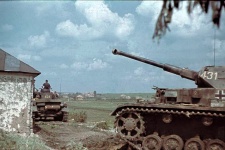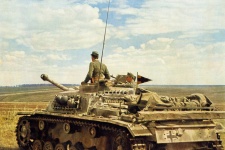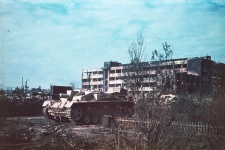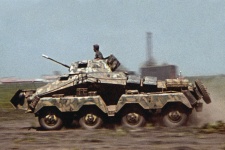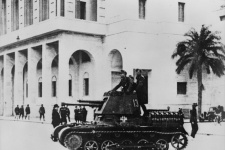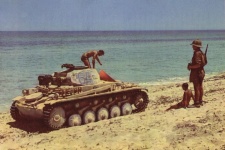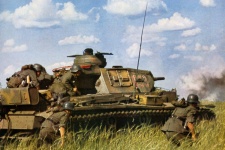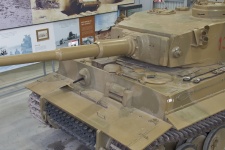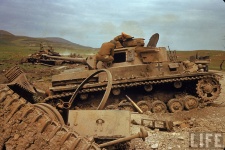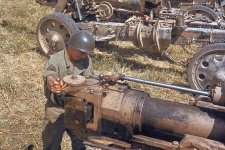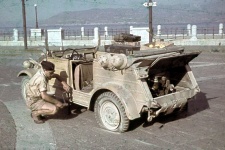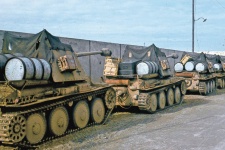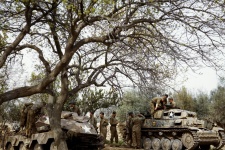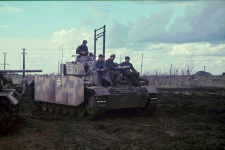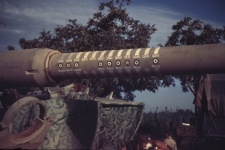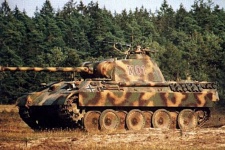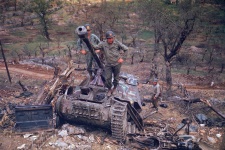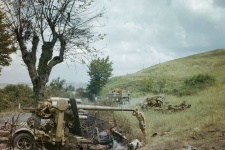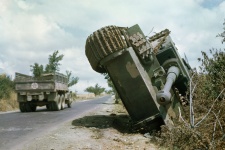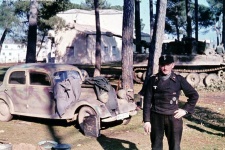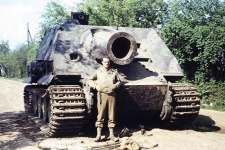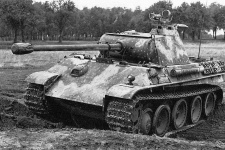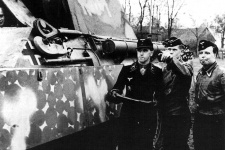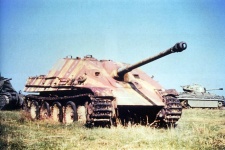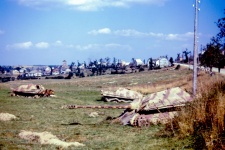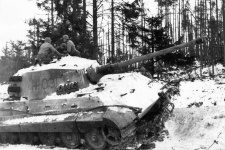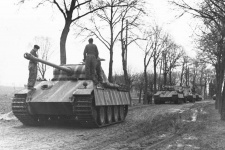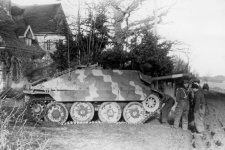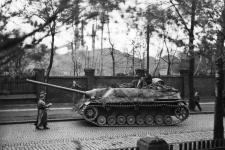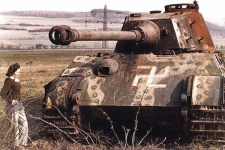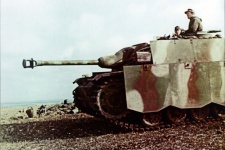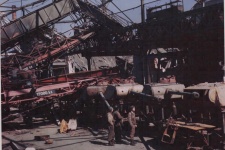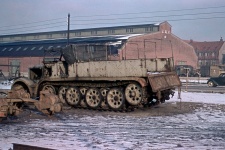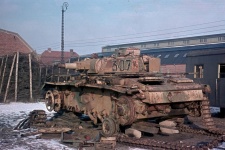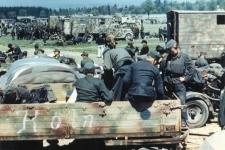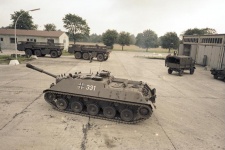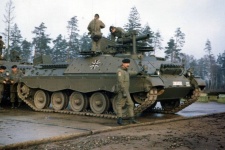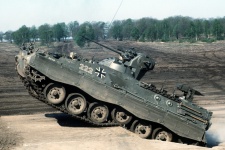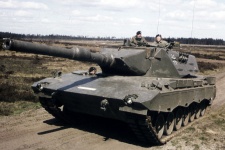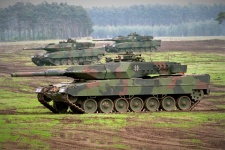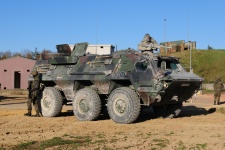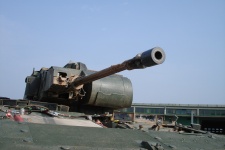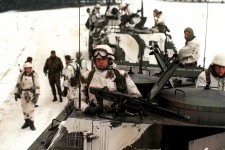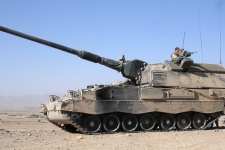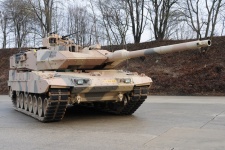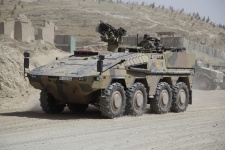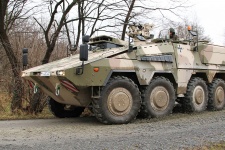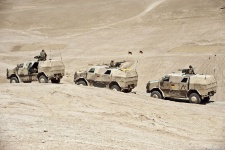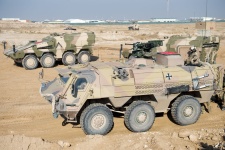AFV Colors and Camouflage, Wehrmacht & Bundeswehr
![]()
Introduction to German color standards for ground vehicles
The main color standard used in Germany was conceived in 1927 by the Reichs-Ausschuß für Lieferbedingungen (the National Committee for Delivery and Quality Assurance) and introduced as RAL 840. An initial revision took place in 1932 resulting in RAL 840 B 2, a 40 color palette which would include all the colors in use by the Wehrmacht at the start of the war. A further revision known as RAL 840 R was introduced in 1939-40 and replaced the original single- or double-digit numbering with the now standard four-color nomenclature where the first digit indicates the hue, these being yellow (1), orange (2), red (3), violet (4), blue (5), green (6), gray (7), brown (8), and white and black (9). The remaining digits represent each individual shade and are added chronologically. The RAL system was used by all of the Wehrmacht's ground forces which included the Heer (Army) and the Luftwaffe (Air Force) as well as the separate Schutzstaffel (SS), Luftwaffe aircraft adopted a separate color standard known RLM (named after the Ministry of Aviation or Reichsluftfahrtministerium). Responsibility for Wehrmacht camouflage rested on the Oberkommando des Heeres (OKH), the Army high command.
It was customary to add new colors to the palette, and these were eventually standardized in 1961 into a new palette known as RAL 840-HR with 210 colors and which is the current standard in use to this day. Notably, numerous wartime colors including widely used ones like RAL 7028 Dunkelgelb were not incorporated. The absence of different sheens in the standard palette (all colors in RAL 840-HR are matt) resulted in the introduction of RAL 841-GL in 1986 which was composed of 193 gloss colors. Around this time, numerous other complementary palettes for design purposes were introduced resulting in the RAL 840 palette now being often referred to as RAL Classic. Additionally, a mini-palette of nine colors for military use was consolidated into RAL F9 in 1984 and is currently the standard palette for all Bundesheer AFVs. These feature the same nomenclature as regular RAL colors with the prefix -F9 added to their numbers.
Contents:
- Wehrmacht
- Bundeswehr
External Links:
- Facts about German Camouflage Paint in World War II by Thomas L. Jentz and Hilary L. Doyle (Missing-Lynx)
- Wehrmacht colors & camouflage (Bergflak's Lounge)
- World War 2 German Camouflage and Tactical Markings Part I by Mr Tretiak
References:
- Culver, Bruce and Murphy, Bill, Panzer Colors , Vol. 1: Camouflage of the German Panzer Forces, 1939-1945, Squadron/Signal Publications (1976)
- Kiroff, Jürgen et al, Real Colors of WWII, AK Interactive (2017)
Color guide basics:
All colors in this page include a color guide with matches or equivalences from 19 different model paint ranges. Paints are considered matches if they are labeled with the intended color (either uniquely or together with another color). Paints are considered equivalences if they are close to the intended color but not labeled as such. The accuracy of any paint is independent of whether it is a match or an equivalence and these are described in the text (there can be poor matches and highly accurate equivalences). The following nomenclature is used in the paint tables and is based on matches or equivalences to US Insignia Red FS 11136:
| Paint | Match or equivalence type (label) |
| MP01 | Labeled to match one specific color (FS 11136) |
| MP02* | Labeled to match more than one color of same-country standards (FS 11136 / ANA 509)* |
| MP03** | Labeled to match more than one color of different-country standards (FS 11136 / BS 538) |
| MP04 (!) | Questionable accuracy of label match (doesn't look like FS 11136) |
| MP05 (?) | Questionable accuracy of label match, untested (doesn't look like FS 11136 in the bottle or photos) |
| (MP06) | Known close equivalent to FS 11136 (BS 538) |
| (MP07) (?) | Questionable equivalent to FS 11136 (Generic Gloss Red) |
* A single asterisk also denotes implicit matches for same-country standards where there is an official succession between standards. For example, H327* would match ANA 509 even if the label only references FS 11136 since ANA 509 is its official predecessor. This does not apply when there are considerable differences between successive paints (ex: Olive Drab No. 41/ANA 613/FS 34087) and this will be described in the text. By and large, however, single asterisk matches should be considered close enough to unique matches as to not be seriously questioned.
The paint charts make no distinction between gloss, semi-gloss, and matt variants of a color if the correct sheen is unavailable (ex: gloss FS 11136 will be a specific match for matt FS 31136 if the latter does not exist in the same paint range). Exceptions are made where there is a known or suspected color difference (ex: FS 24087 and 34087).
Revision 2024 Changes: Unless stated otherwise, text and Color Guide tables now refer to the new formulas of Gunze Mr. Hobby Aqueous (2020) and new series of AK Real Colors (2024), while AK 3rd Generation Acrylics (2020) have now replaced the now discontinued original AK acrylic series. Colourcoats have sadly been discontinued and has also been removed.
![]()
Wehrmacht
Early war disruptive scheme (1939-40)
When World War II began, the color and camouflage of German AFVs was governed by OKH resolution H. M. 1937 Nr. 340 dated 12 July 1937. This specified a two-tone camouflage which consisted of RAL 7021 Dunkelgrau (Dark Gray) base and a disruptive pattern of RAL 7017 Dunkelbraun (Dark Brown) which was to cover one-third of the vehicle. RAL 7021 would become one of the most recognizable colors used by the Wehrmacht in World War II, one that is synonymous with the early war Blitzkrieg. It is a very dark gray which occasionally appears with a subtle blue tone depending on color balance (especially after fading) although it is worth noting that the original color does not have any blue in it. It would seem that RAL 7021 was not a particularly good color for camouflaging under any conceivable environment although that does not appear to have been its purpose: it was actually designed to hide vehicles in the shade. It remains in the RAL palette to this day, although the current iteration is noticeably darker which has led to suggestions that RAL 7016 (Anthracite Gray) is actually the closest modern equivalent. Meanwhile, RAL 7017 is a very dark brown with nearly identical lightness as RAL 7021. This has had an unfortunate consequence for those seeking to identify it, namely that both colors are virtually indistinguishable from each other in black and white photos. Evidence of its use is therefore only possible with the handful of color photos from the early war years. To complicate matters, it was only applied on a discretionary basis meaning that many vehicles were left simply with an overall base coat of RAL 7021.
The early-war scheme was in use until July 1940 after which the Blitzkrieg campaign in the West was over. From that point on, it was decided to simply keep RAL 7021 as an overall coat. Nevertheless, it was customary to only repaint vehicles when needed which means many vehicles which had a RAL 7017 disruptive pattern likely retained it for longer, in some documented cases even after the invasion of the USSR in June 1941.
Paint guide:
- RAL 7021 Dunkelgrau: This is one of the few AFV colors of any nation that has been reproduced by ever paint brand listed on this site. Tamiya XF-63 has been a long-standing favorite but it is lighter and bluer than the color ship so works best for scale effects (especially on smaller 1/72 and 1/76 models) and fading. Gunze's original version of this color is C40/H32 which is too dark and probably more appropriate for the post-war version. A newer version based on a modulation set is C513/H513 and is much recommended over C40/H32. The AK Real Colors is a pure gray and might put off those that want at least a slight hint of blue in the color. By and large, however, this is a relatively easy color to get right and even mild deviations from the official color cards do not look bad at all on a model.
- RAL 7017 Dunkelbraun: Painting early-war German vehicles overall RAL 7021 has long been a modeling convention and as a result, RAL 7017 is very poorly represented aside from a handful of newer brands. The AK Real Colors version looks very much the part and most others don't seem too far off. Gunze users may consider C41/H47 which is a very dark brown unlike its label (red brown) suggests. Darkening any standard brown to roughly the same level as the gray should work, as this was a very low contrast combination.
| RAL 7021 | RAL 7017 | |
| Dunkelgrau | Dunkelbraun | |
| Schemes | ||
| Early | Base | Camo |
| Color matches | ||
| Gunze Mr. Color | C513 | - |
| Gunze Mr. Hobby | H513 | - |
| Humbrol | 67 | - |
| Italeri | 4795AP | - |
| Model Master | 2094 | - |
| Revell | 09 | - |
| Tamiya Acrylic | XF-63 | - |
| Tamiya Lacquer | LP-27 | - |
| Vallejo Model Air | 71.056 | - |
| Vallejo Model Color | 70.862 | - |
| AKAN | 61005 | 61201 |
| AK 3Gen Acrylic | AK11316 | AK11315 |
| AK Real Colors | RC856 | RC855 |
| AMMO by Mig | A.MIG-008 | A.MIG-007 |
| Hataka | HTK-_164 | HTK-_168 |
| Lifecolor | UA 207 | UA 210 |
| Mission Models | MMP-014 | MMP-139 |
| Mr. Paint | MRP-034 | - |
| Xtracolor | X800 | - |
| Xtracrylix | X1800 | - |
Dunkelgrau scheme (1940-43)
Shortly after the end of the 1940 campaign in France, it was decided to simplify the color scheme to a base coat of RAL 7021 Dunkelgrau with no disruptive camouflage in order to save paint. This order was specified in H. M. 1940 Nr. 864 from 31 July 1940. Aside from operations in the Balkans there was little activity on the ground in Europe until 22 June 1941 when Germany invaded the USSR (Operation Barbarossa), thus opening the largest land front of the war. Changes to the default color scheme eventually became necessary upon the arrival of the first snowfall in October, as the RAL 7021 became even more conspicuous against white terrain. The following month saw the introduction of a white emulsion that could be used as winter camouflage, and which would be applied on a discretionary basis. This paint likely matched RAL 9001 Weiß (White), a cream white that was used on insignia and markings. However, supply issues meant that it was common to use whatever form of white camouflage was available such as chalk or lime. This resulted in German winter camouflage appearing patchy and heavily worn particularly during the winter of 41/42 when the supply of RAL 9001 was still erratic.
It was also common to see vehicles during and after Barbarossa to have some form of earthly camouflage. In some cases, particularly early in the campaign, dried mud was used but the introduction of desert colors for vehicles in North Africa found a use on the Eastern Front as well. The Afrika scheme, which is described in more detail in its own section below, was initially issued on 17 March 1941 and consisted of a disruptive pattern of RAL 8000 Gelbbraun (Yellow-Brown) and RAL 7008 Graugrün (Gray-Green). These were replaced by RAL 8020 Braun (Brown) and RAL 7027 Grau (Gray) from 25 March 1942 but the order specified that existing paint stocks had to be used up first. The use of the Afrika scheme on the Eastern Front has been attributed to factory-painted vehicles destined for North Africa but which were tranferred to the Eastern Front due to chronic equipment shortages. But photographic evidence suggests that it was much more widespread, and may have been factory applied for a large proportion of the newer long-barreled tanks and assault guns that entered service in 1942 (Panzer IV Ausf F2/G/H, StuG III Ausf F/G, Tiger I). Its use was most prominent during the 1942 German summer offensive in Southern Russia and Ukraine (Fall Blau) where it proved more suitable to the steppe than Dunkelgrau, but it was also seen in the central and norther sections of the front.
Aside from vehicles fully painted in the Afrika scheme, RAL 8000 and RAL 8020 was used extensively as an ad hoc disruptive camouflage on Dunkelgrau vehicles, taking the form of mottle, patches, or irregular lines. This type of camouflage was most common on older short-barreled tanks, armored cars, and armored personnel carriers. Conversely, Dunkelgrau itself was often applied in a similar manner to vehicles that had been delivered in the Afrika scheme. There is photographic evidence that non-standard colors were applied to many vehicles as well, including lighter browns and greens. As the summer offensive progressed into the autumn, the proportion of vehicles displaying some form of camouflage (often very subtle in black and white photos) significantly increased, to the point that vehicles unequivocably painted in single-tone Dunkelgrau became a rarity once winter camouflage began to be applied later in the year.
The use of Afrika colors on the Eastern Front has long been a source of erroneous information on color profiles and model kit instruction manuals, namely due to the belief that any earthly color on the Eastern Front was the later RAL 7028 Dunkelgelb. This would have been highly unlikely before 18 February 1943 when that color was first introduced. Consequently, any earthly color seen on the Eastern Front before February 1943 was necessarily one of the Afrika colors or some other ad hoc field-applied camouflage such as dried mud. This applied to vehicles engaged throughout the 1942 summer offensive, the Battle of Stalingrad, and the third Battle of Kharkiv. Even though the latter battle began around the time of the switch to Dunkelgelb, it would have proven difficult to repaint vehicles under intense combat conditions although it is conceivable that a small number of new vehicles factory-painted in Dunkelgelb may have arrived in the later stages of the nearly month-long battle, or were painted before the official switch (stocks of the new paint are known to have existed in some factories since December 1942). Even so, all new vehicles sent to the Eastern Front during the winter of 1942/43 until the end of February were ordered to be delivered with winter camouflage, which would make it practically impossible to tell if they had left the factories in Dunkelgelb.
Paint guide:
- RAL 7021 Dunkelgrau: see above.
- RAL 9001 Weiß: It is pointless to be too pedantic over this color being indistinguishable in practice from any other off-white like FS 36875 (Insignia White). For those looking for an exact match, most of the newer paint brands have it covered. One notable omission is Mr. Paint which carried it only in its now discontinued Aqua range (MRP-A023) yet strangely not in its main lacquer range.
- RAL 8000 Gelbbraun: see below.
- RAL 8020 Braun: see below
Links:
- Tropen cammo colours in the Soviet Union (1942, Fall Blau) (Missing-Lynx)
- A study case on Dunkelgrau appearance in B&W photos (Missing-Lynx)
| RAL 7021 | RAL 9001 | RAL 8000 | RAL 8020 | |
| Dunkelgrau | Weiß | Gelbbraun | Braun | |
| Schemes | ||||
| Basic | Overall | |||
| Winter | Base | Camo | ||
| Afrika (1) | Base | Camo (1) | Camo (2) | |
| Afrika (2) | Camo | Base (1) | Base (2) | |
| Color matches | ||||
| Gunze Mr. Color | C513 | - | - | - |
| Gunze Mr. Hobby | H513 | - | - | - |
| Humbrol | 67 | - | - | - |
| Model Master | 2094 | - | 2099 | 2102 |
| Revell | 09 | 05 | - | 17 |
| Tamiya Acrylic | XF-63 | - | XF-92 | XF-93 |
| Tamiya Lacquer | LP-27 | - | LP-76 | LP-77 |
| Vallejo Model Air | 71.056 | 71.270 | 71.272 | 71.117 |
| Vallejo Model Color | 70.862 | 70.918 | 70.879 | - |
| AKAN | 61005 | 61089 | 61040 | 61079 |
| AK 3Gen Acrylic | AK11316 | - | AK11327 | AK11331 |
| AK Real Colors | RC856 | RC807 | RC861 | RC865 |
| AMMO by Mig | A.MIG-008 | A.MIG-017 | A.MIG-013 | A.MIG-016 |
| Hataka | HTK-_164 | HTK-_307 | HTK-_303 | HTK-_305 |
| Lifecolor | UA 207 | - | UA 203 | UA 201 |
| Mission Models | MMP-014 | - | MMP-017 | MMP-010 |
| Mr. Paint | MRP-034 | - | MRP-213 | MRP-214 |
| Xtracolor | X800 | - | X803 | X808 |
| Xtracrylix | X1800 | - | XA1803 | XA1808 |
Afrika 1 scheme (1941-42)
The Deutsches Afrikakorps (DAK) arrived in North Africa on February 1941, initially using the same overall Dunkelgrau scheme used in Europe. This would quickly prove inconvenient in the Libyan desert where much of the campaign was to be fought, which prompted units to improvise camouflage such as through the use of dry mud or sand. It did not take long for the first official Afrika camouflage scheme to be introduced in H. M. 1941 Nr. 281, issued on 17 March 1941. This is often referred to as the Tropen scheme even though the term, popularized by contemporary researchers and enthusiasts, is not known to have ever appeared on offical documentation. The new order specified a new base color of RAL 8000 Grünbraun (Yellow-Brown) and a disruptive pattern of RAL 7008 Graugrün (Gray-Green) which was to cover one-third of the vehicle, using similar patterns to those of the early war RAL 7021/7017 scheme. These were both colors that already existed in the RAL palette and were seen as the most suitable for desert warfare. RAL 8000, as its name suggests, was a standard golden brown whereas RAL 7008 was a khaki gray (it remains in the modern RAL palette as Khakigrau). Although the disruptive effect was low contrast, the two colors are easier to distinguish in black and white photos than RAL 7021/7017. The use of disruptive camo was discretionary in practice, meaning that many vehicles were only ever painted with a RAL 8000 base. Many older vehicles in overall Dunkelgrau were not fully repainted in Afrika colors and instead were oversprayed with RAL 8000 in irregular patterns, resulting in an effect similar to those that had been camouflaged earlier with dry mud or sand.
The use of the initial Afrika scheme (henceforth referred to as Afrika 1) ended on 25 March 1942 but it was advised not to repaint vehicles into the new scheme unless strictly necessary. As such, Afrika 1 colors continued to be seen well into 1942 while paint stocks were still available. Notably, many of the initial Tiger I tanks that were sent to the Tunisian theater in late 1942 remained factory-painted in Afrika 1 colors, a possible explanation being that Henschel might have had larger stocks of RAL 8000/7008 than other manufacturers. Although museum vehicles are frequently painted inaccurately, it has been stated that the colors of the famous 'Tiger 131' owned by the Bovington Tank Museum in the UK were reproduced based on sections of undamaged paint left on the tank when captured, although the glossy finish (used to make the tank easier to clean) makes the colors look slightly darker. As mentioned in the previous section, a large number of Afrika 1 scheme vehicles were sent to the Eastern Front where more color photographs of this scheme in action have survived.
Paint guide:
- RAL 8000 Gelbbraun: This is a very well covered color although three big brands (Gunze, Humbrol, and Revell) lack it. Tamiya's interpretation is on the browner side and quite good, while Vallejo's offerings appear too dark (there is also its 70.606 primer). AK Real Colors and Lifecolor appear to be the best of the bunch, capturing the ochre-like shade very well.
- RAL 7008 Graugrün: For a long time it was modeling convention to simply paint DAK vehicles in their base colors and consequently, few of the traditional brands cover RAL 7008 or 7027, the exception being Model Master. An important consideration is that RAL 7008 needs to harmonize well with RAL 8000 given the relatively subtle differences between the two and with that in mind, Gunze, and Lifecolor seem to work best whether or not you agree with their interpretation of their shades. There is also a Revell version which is likely to match the current RAL color. Tamiya's XF-49 has been suggested as a generic alternative.
Links:
| RAL 7021 | RAL 8000 | RAL 7008 | |
| Dunkelgrau | Gelbbraun | Graugrün | |
| Schemes | |||
| DAK Early | Base | (Camo) | |
| Afrika 1 | Base | Camo | |
| Color matches | |||
| Gunze Mr. Color | C513 | - | - |
| Gunze Mr. Hobby | H513 | - | - |
| Humbrol | 67 | - | - |
| Italeri | 4795AP | - | - |
| Model Master | 2094 | 2099 | 2098 |
| Revell | 09 | - | 86 |
| Tamiya Acrylic | XF-63 | XF-92 | - |
| Tamiya Lacquer | LP-27 | LP-76 | |
| Vallejo Model Air | 71.056 | 71.272 | 71.116 |
| Vallejo Model Color | 70.862 | 70.879 | - |
| AKAN | 61005 | 61040 | 61041 |
| AK 3Gen Acrylic | AK11316 | AK11327 | AK11313 |
| AK Real Colors | RC856 | RC861 | RC853 |
| AMMO by Mig | A.MIG-008 | A.MIG-013 | A.MIG-005 |
| Hataka | HTK-_164 | HTK-_303 | HTK-_304 |
| Lifecolor | UA 207 | UA 203 | UA 212 |
| Mission Models | MMP-014 | MMP-017 | MMP-008 |
| Mr. Paint | MRP-034 | MRP-213 | MRP-211 |
| Xtracolor | X800 | X803 | X804 |
| Xtracrylix | X1800 | XA1803 | - |
Afrika 2 scheme (1942-43)
By 1942 it had become apparent that the RAL 8000/7008 combination was not ideal for North Africa and that specific colors for desert warfare needed to be developed. As a result, two new colors were introduced into the RAL palette and specified for use on vehicles in Africa by H. M. 1942 Nr. 315, issued on 25 March 1942. This will be referred to as the Afrika 2 scheme, also unofficially known as the Tropen 2 scheme. The new base color was to be RAL 8020 Braun (Brown), which was noticeably lighter than its RAL 8000 predecessor and closer to a desert pink. The new disruptive color was RAL 7027 Grün (Gray) which, contrary to its very generic name, had a greenish tone. Compared to the previous combination, the new colors disployed much higher contrast between them although it remained common for many vehicles to be left in just the RAL 8020 base.
Existing stocks of RAL 8000/7008 paint were ordered to be used up before repainting vehicles into the new colors, and as a result, the Afrika 2 scheme did not become widespread until well into the second half of 1942. An amendment to the order issued on 3 July 1942 also specified that the new Tropen scheme should be applied to vehicles stationed in Crete, this being the only part of Europe where the Afrika scheme was officially applied. Nevertheless, by the second half of 1942, the logistical situation facing the DAK was precarious due to the interdiction of Axis shipping across the Mediterranean. This meant that DAK units frequently relied on captured British paints as well, most notably after the capture of Tobruk in June 1942 which resulted in a huge bounty of British supplies taken over by the Axis. The result is that by the time of the Battle of El Alamein, DAK vehicles were painted in a motley array of different camouflage styles and colors which, in proper German tradition, was done at the discretion of unit commanders.
The Axis retreat into Tunisia in late 1942 resulted in a change of environment from desert to more verdant, Mediterranean-like terrain. There is considerable debate on whether non-standard colors were used during this phase of the campaign, but evidence is non-conclusive. The most well-known controversy is over the alleged use of an 'olive' paint on some Tiger I tanks of sPzAbt 501 after their arrival in Tunisia. The exact nature of this color is unclear, with RAL 7008 or RAL 6003 usually cited. Captured US Olive Drab has also been suggested. Unfortunately, the only visual evidence for this claim are a small number of black and white photos which show a Tiger looking darker than usual. Although claims like these have been made by some authoritative sources (and also debunked by equally authoritative ones), the burden of proof remains on those stating with certainty that non-standard colors were used.
Lastly, a new tricolor scheme based around RAL 7028 Dunkelgelb (see below) was issued on 18 February 1943, a few months before the North Africa campaign concluded. The order specified that this new scheme was to be applied on all fronts, thereby rescinding the Afrika 2 scheme from use. There is some documented evidence of vehicles in the new scheme finding their way to Tunisia, although the tight Allied air and naval blockade around the shrinking Axis beachhead meant that only a trickle of new vehicles were arriving by this period of the campaign. As a result, the Afrika scheme predominated until the Axis surrender on 13 May 1943. Limited use of the Afrika scheme was also documented in the subsequent camapigns in Sicily.
Paint guide:
- RAL 8020 Braun: Also very well covered color but one with a huge range in hues given the lack of consensus among paint brands on what this color actually looks like. Tamiya's new XF-93 is very close to the color card and will disappoint nobody, being a bit lighter than AK Real Colors or Vallejo which are too dark. Revell's version is not labeled with a RAL number, simply as a generic Africa Brown, but it is also very accurate. AMMO by Mig and AK's original versions are laughably bad, being essentially sand yellows. Lifecolor and Mission Models are good representations of a very faded version of this color but are otherwise too light.
- RAL 7027 Grau: Much like RAL 7008, very poorly represented among traditional brands and also very different interpretations among the newer ones. The same recommendation with RAL 7008 applies: the shade itself is less important than how well it harmonizes with the base color. You can usually do no wrong in picking the same brand for RAL 7027 that you used for RAL 8020.
Links:
- Tiger ausf. E : RAL 8020 paint (David Byrden)
| RAL 8020 | RAL 7027 | |
| Braun | Grün | |
| Schemes | ||
| Afrika 2 | Base | Camo |
| Color matches | ||
| Gunze Mr. Color | - | - |
| Gunze Mr. Hobby | - | - |
| Humbrol | - | - |
| Italeri | - | - |
| Model Master | 2102 | 2103 |
| Revell | 17 | - |
| Tamiya | XF-93 | - |
| Tamiya Lacquer | LP-77 | - |
| Vallejo Model Air | 71.117 | 71.118 |
| Vallejo Model Color | - | - |
| AKAN | 61079 | 61202 |
| AK 3Gen Acrylic | AK11331 | AK11317 |
| AK Real Colors | RC865 | RC857 |
| AMMO by Mig | A.MIG-016 | A.MIG-009 |
| Hataka | HTK-_305 | HTK-_306 |
| Lifecolor | UA 201 | UA 202 |
| Mission Models | MMP-010 | MMP-016 |
| Mr. Paint | MRP-214 | MRP-212 |
| Xtracolor | X808 | X809 |
| Xtracrylix | XA1808 | XA1809 |
Tricolor Scheme (Feb 1943)
A major revision to the Wehrmacht’s standard camouflage scheme was implemented with H. M. 1943, Nr. 181 on 18 February 1943, abandoning Dunkelgrau in favor of colors more suitable for camouflaging against terrain. This new scheme was based around a newly introduced color known as Dunkelgelb (Dark Yellow) which went through numerous modifications over the remainder of the war, and is consequently a subject of continuous debate among researchers and enthusiasts. The initial version of this color as introduced in February was known as Dunkelgelb nach Muster which translates to “Dark Yellow according to sample”, and its quasi-experimental nature is evident by the fact that it was not initially given a RAL number. Unlike later variants, there is little disagreement over how this color looked: a mustard yellow which is probably closest to the stereotypical interpretation of Dunkelgelb in media such as movies and videogames. Nevertheless, the color was criticized by troops for being too conspicuous. It was therefore tweaked ahead of its official incorporation into the RAL palette (as RAL 7028 Dunkelgelb) on 31 August, by which time the 1943 summer battles around Kursk and Kharkiv had ended. This second version (or first official version) of Dunkelgelb was a medium tan rather than a yellow which undoubtedly made it better suited as a camouflage color on both the Eastern Front and Italy, which would be the main theaters of war for German forces in the months after it was introduced. For snowy terrain, winter camouflage remained unchanged from the previous scheme, this being washable white emulsion applied over existing colors and removed or repainted once winter was over. From 11 October 1943 (H. T. V. BI. 1943, Nr. 376), RAL 9002 Weiß (White) became the new standard white used by the Wehrmacht and had a greyish shade compared to the previous cream white shade of RAL 9001.
Dunkelgelb was complemented by two additional colors, RAL 6003 Olivgrün (Olive Green) and RAL 8017 Rotbraun (Red-Brown). These were to be applied at the discretion of field commanders in disruptive patterns based on their suitability to local conditions. RAL 6003 was a medium-dark olive(ish) green identical to the Luftwaffe's RLM 62 which was used for painting ground installations, while RAL 8017 was a dark chocolate brown, which is how it would be rebranded in the post-war RAL palette (Schokoladenbraun). In order to facilitate transportation and storage, all three of the new colors were formulated as a concentrated paste which would be thinned with water or gasoline prior to application by brush, rag, or spray. However, the extent to which the paste was thinned would have a noticeable effect on each color's shade: more heavily thinned paste resulted in lighter and brighter colors compared to the official color cards. This would go a long way towards explaining the wide variety of shades of seen on photos, and which has led to the belief that different versions of these colors existed. When over-thinned, RAL 6003 lightened to a grass green whereas RAL 8017 lightened to a brick red. Dunkelgelb also displayed considerable variation between tan and yellow, and at its lightest appeared as a pale cream. H. M. 1943, Nr. 181 further specified that remaining Dunkelgrau vehicles, including newly manufactured ones, were to be fully repainted as soon as possible in the new scheme if they were part of replacement or occupation units. But vehicles in field units were to retain their original colors and have the new colors applied as disruptive patterns, similar to how Afrika colors were applied over Dunkelgrau vehicles in 1941-42.
The new camouflage scheme gave unit commanders considerable flexibility on applying colors and patterns on the basis of operational requirements. But paint availability would also become a determinant: by 1943, German industry had begun to be severely disrupted by Allied bombing which led to considerable supply problems that only got worse as the war progressed. After the defeats at Stalingrad and Kursk, the German army found itself on the retreat, which complicated the ability of front line units to repaint their vehicles in a proper manner. The result was that many vehicles were left in their Dunkelgelb base coat or used foliage in lieu of the disruptive colors. Gasoline shortages also resulted in water or waste fuel being used more often to thin the pastes but this caused the paint to be less durable, in some cases lasting just a few days before running or washing off. The result of all of these problems was a camouflage scheme that all too often did not reach its potential even though as a whole, it was undoubtedly more effective for concealment than the Dunkelgrau scheme that preceded it.
Paint Guide:
- Dunkelgelb nach Muster: Ironically, this appears to be the version of Dunkelgelb which most of the older paint brands appear to have unwittingly aimed for, notably Tamiya’s original XF-60 which has since been revised to a browner shade.. A small number newer brands make a specific version for this color although some may be assumed to match despite the label (such as Akan's 61080 labeled Mustard - Dark Yellow). Despite being a transitory color, it should not be forgotten than this was the version of Dunkelgelb used during the Battle of Kursk.
- RAL 7028 Dunkelgelb: This refers to the second version of Dunkelgelb and first to be formally introduced into the RAL palette. Tamiya has two versions of Dunkelgelb which include the older XF-60 and the newer XF-88. Neither looks particularly close to the color card, unfortunately, with the recently revised XF-60 looking a bit more tan than the lighter and yellower XF-88. The lacquer version (LP-55) is not much better either, looking too yellow. Both AK Real Colors and Mission Models err on the side of being too pale, looking more like a deck tan or buff. Gunze's C39/H79 is poor, having a golden yellow tone that does not resemble the color card. This is unfortunate, since the old formulation of H79 was possibly the most accurate Dunkelgelb ever made in acrylic. Hataka is probably the best currently available version of Dunkelgelb, similar in tone and just slightly darker than the old H79.
- RAL 6003 Olivgrün: This is a less controversial color and therefore hard to get wrong, with lighter interpretations arguably better in order to lessen the contrast with Dunkelgelb which tends to be lighter than it should be. Tamiya’s XF-58 has long been used for this color and it is a decent match, though its newer XF-89 version is even better looking very close to the color card. AK Real Colors is much brighter than the color card and one would be tempted to call it inaccurate were it not for the fact that it does resemble the color that resulted from heavily thinned paste. Gunze's C70 seems too dark and does not resemble the excellent but now discontinued H405. Most other brands look good in the bottle and should be fine. Note that AMMO by Mig and AK (original) offer two versions and in both cases the second option appears closer (more olive, less deep green).
- RAL 8017 Rotbraun: Tamiya’s XF-64 used to be an excellent match but recent formula changes have stripped it of its reddish hue making it look more like a dark earth. Its replacement, XF-90, is unfortunately awful and that is putting it kindly: it has a bizarre puke-green hue to it with none of the red making it possibly the most inaccurate color Tamiya has ever produced. Hopefully this will be corrected in a future formula change but in the meantime, avoid. Gunze's H47/C41 is a far too dark brown with hardly any red to it and should also be avoided, which is a shame since the now discontinued H405 was much better, if on the darker side. AK Real Colors nailed it perfectly and is my pick for the best representation out of the bottle. Many others appear too dark and too brown which, although closer to the original color card, might not harmonize well with the other colors (especially Dunkelgelb) on a scale model.
- RAL 9002 Weiß: The usual comment about using any off-white applies here since this is a much less well represented color than RAL 9001, with only Akan, AK Real Colors and Vallejo offering it. Unfortunately for those looking to capture the proper greyish shade, the typical generic off-white may not be as suitable since they tend to be cream whites. As such, mixing a standard white with a drop of any neutral gray (the lighter the better) is probably your best bet. Gunze's generic off-white (C69/H21) has a greyish shade and is a perfectly suitable alternative.
Links:
- How to Paint Tiger Tanks (The Tank Museum)
- Real Colors Acrylic Lacquer Paints (IPMS/USA Reviews)
- Real RAL 7018 vs AK Real Color Dunkelgelb set (FineScale Modeler)
- Two Different Dunkelgelbs? (FineScale Modeler)
| RAL 7028 | RAL 6003 | RAL 8017 | RAL 9002 | ||
| Dunkelgelb nach Muster | Dunkelgelb | Olivgrün | Rotbraun | Weiß | |
| Schemes | |||||
| Feb. 1943 | Base | Camo | Camo | ||
| Aug. 1943 | Base | Camo | Camo | ||
| Winter | Base | Camo | Camo | Camo | |
| Color matches | |||||
| Gunze Mr. Color | - | C39 (!) | C70 | C41 (!) | (C69) |
| Gunze Mr. Hobby | - | H79 (!) | - | H47 (!) | (H21) |
| Humbrol | - | - | - | - | - |
| Italeri | - | 4796AP | 4798AP | 4797AP | - |
| Model Master | - | 2095 | 2149 | 2096 | - |
| Revell | - | - | 61 | - | - |
| Tamiya Acrylic | - | XF-60 XF-88 |
XF-58 XF-89 |
XF-64 (!) XF-90 (!) |
- |
| Tamiya Lacquer | - | LP-55 | LP-56 | LP-57 | - |
| Vallejo Model Air | - | 71.025 | 71.092 | 71.041 | 71.119 |
| Vallejo Model Color | - | 70.978 | 70.890** | 70.985 | 70.883** |
| AKAN | 61080 | 6/71003 | 6/71001 | 6/71010 | 6/71090 |
| AK 3Gen Acrylic | - | AK11318 | AK11309 (1) AK11310 (2) |
AK11330 | - |
| AK Real Colors | RC858 | RC859 | RC852 | RC864 | RC809 |
| AMMO by Mig | - | A.MIG-010 | A.MIG-002 | A.MIG-015 | - |
| Hataka | HTK-_310 | HTK-_244 | HTK-_169 | HTK-_147 | - |
| Lifecolor | - | UA 204 | UA 206 | UA 205 | - |
| Mission Models | - | MMP-011 | MMP-009 | MMP-012 | - |
| Mr. Paint | - | MRP-037 | MRP-035 | MRP-036 | - |
| Xtracolor | - | X805 | X806 | X807 | - |
| Xtracrylix | - | XA1805 | XA1806 | XA1807 | - |
Tricolor scheme (Aug 1944)
In theory, the flexibility afforded by the tricolor scheme allowed unit commanders to quickly adapt camouflage to any given environment or combat condition. In practice, the acute shortages facing the German armed forces from 1943 onward resulted in a chaotic and inconsistent application of camouflage. The delivery of vehicles in Dunkelgelb basecoats from the factories to the frontlines made them easily visible and vulnerable to aircraft, especially after the summer of 1944 when Allied air supriority became overwhelming. As a result, it was ordered on 19 August 1944 to apply disruptive camouflage directly from the factory, using RAL 7028 Dunkelgelb (Dark Yellow), RAL 6003 Olivgrün (Olive-Green), and RAL 8017 Rotbraun (Red-Brown) in roughly equal proportions and minimal overspray. Wheels were also painted in any of the three colors before installation and picked randomly for each vehicle. However, RAL 6003 and RAL 8017 strongly predominated to the extent that many vehicles had no wheels in RAL 7028 at all.
The new order also introduced a new Hinterhalt-Tarnung or ‘Ambush’ camouflage styles which were meant to resemble sunlight shining through trees, the purpose being to improve concealment among heavy foliage. The 'dot style' was applied to vehicles produced by Daimler-Benz and Henschel and featured speckled spots of a contrasting color (RAL 7028 spots over RAL 6003 or RAL 8017, and vice versa). Some variants had triangular ('corn chip' style) or rectangular spots. The 'disc style' was applied to vehicles produced by MAN and MHN nd had the two main disruptive colors (RAL 6003 and RAL 8017) applied in circles of varying sizes which did not fully overlap, exposing the RAL 7028 basecoat between them. Initial application of the Ambush styles varied between factories, with some not commencing to deliver vehicles until September and most abandoning it by October. Vehicles without any of the Ambush styles but retaining the roughly equal proportions of the three disruptive colors are sometimes referred to as the 'classic' scheme which some factories continued to apply until the end of the war.
In mid-September, there was a further revision to the scheme which called for RAL 8012 Rotbraun (Red-Brown) red oxide primer to be used as the basecoat. But what follows is a source of considerable confusion and debate. One view has it that RAL 7028 and RAL 6003 were used as disruptive camouflage over the exposed RAL 8012 primer, which meant that RAL 8017 was no longer needed. This would make sense given the similarities between RAL 8012 and RAL 8017, although the latter is visibly darker and browner when properly applied. The other view has it all three original camoufalge colors (RAL 7028, RAL 6003, and RAL 8017) were painted over the primer and that no part of the primer was intentionally left exposed. A definitive answer to this conundrum is complicated by the fact that two of the leading researchers on German armor (Hilary Doyle and Tom Jenck) have contradicted themselves on this matter and have not cited any primary sources supporting either view. Conclusive evidence is made even more difficult by the fact that these colors would be hard if not impossible to tell apart in a wartime-quality photo.
In October, MNH, MAN, and MIAG introduced a new camouflage schemes that were considerably different than the 'classic' scheme. The MNH version, applied on Panthers and Jagdpanthers, was particularly notable as it featured wide diagonal stripes of RAL 6003 and RAL 8017 (or RAL 8012 if the exposed primer view is believed), separated by a narrower stripe of RAL 7028. For some vehicles, only RAL 7028 and RAL 8017 (or RAL 8012) were used in equally wide stripes. In such cases, narrow stripes of RAL 9002 Weiß (White) could be used as a third color. A later version of this scheme (sometimes known as the 'chevron' variant) reversed the angle of the stripes on the turret compared to the hull. The result was some of the most striking camouflage patterns seen on German vehicles during the war, although probably far too conspicuous to have been an advantage over the earlier ambush patterns. The MIAG scheme used a combination of stripes and patches but also followed a similar principle of using RAL 7028 in narrow contours between the other colors. The MAG scheme offered the least variation from the 'classic' scheme but had the three disruptive colors directed vertically in roughly even proportions, although with highly irregular contours.
In October 1944 there was a further revision of the RAL palette which resulted in another change to Dukelgelb. According to the color cards, this new RAL 7028 Dunkelgelb Ausgabe 1944 was a slightly darker and greyer tan than the 1943 version. The aforementioned issues affecting the appearance of these colors means that conclusive evidence of Ausgabe 1944 even on a color photo is near impossible, much less on a black and white photo. It can only be assumed that it became the predominant color later in the year once stocks of the older version had run out.
Paint guide:
- RAL 8012 Rotbraun: This is a non-specific color given that all red oxide primers look broadly the same which means that even in the absence of a RAL match, any hull red like Tamiya’s XF-9 or Gunze's C29/H17 (the latter oddly named 'Cocoa Brown' but still indicated for ships) are excellent substitutes. For all other ranges, this color is found either as a direct RAL 8012 match or with another name like hull red or red umber (Vallejo). Given that more of the surface area of a vehicle was left painted in this color than in the previous scheme, it is suggested to get the reddish hue right compared to the leeway afforded to RAL 8012 which was used more sparingly in the previous scheme.
- RAL 7028 Dunkelgelb Ausgabe 1944: Of all its Dunkelgelb offerings, AK Real Colors seems to have gotten this one much closer to the relevant color card, whereas the Mission Models interpretation is closer to the desert tan seen on some artifacts. The newer version of Tamiya's XF-60 is browner than the original and also darker than XF-88 which means that it could be seen as more suitable even though it is still too yellow for my liking.
Sources:
- MacDougall, Roddy & Block, Martin (2016). Panther External Appearance & Design Changes. Abteilung 502.
| RAL 7028 | RAL 7028 | RAL 8012 | RAL 8017 | RAL 6003 | RAL 9002 | |
| Dunkelgelb | Dunkelgelb Ausgabe 1944 | Rotbraun | Rotbraun | Olivgrün | Weiß | |
| Schemes | ||||||
| Aug 1944 | Base | Camo | Camo | |||
| Sep 1944 | Camo | Base | Camo (?) | Camo | ||
| Oct 1944 | Camo | Base | Camo (?) | (Camo) | (Camo) | |
| Color matches | ||||||
| Gunze Mr. Color | C39 (!) | - | (C29) | C41 (!) | C70 | (C69) |
| Gunze Mr. Hobby | H79 (!) | - | (H17) | H47 (!) | - | (H21) |
| Humbrol | - | - | - | - | - | - |
| Italeri | 4796AP | - | - | 4797AP | 4798AP | - |
| Model Master | 2095 | - | 2152 | 2096 | 2149 | - |
| Revell | - | - | - | - | 61 | - |
| Tamiya Acrylic | XF-60 XF-88 |
- | (XF-9) | XF-64 (!) XF-90 (!) |
XF-58 XF-89 |
- |
| Tamiya Lacquer | LP-55 | - | - | LP-57 | LP-56 | - |
| Vallejo Model Air | 71.025 | - | 71.271 | 71.041 | 71.092 | 71.119 |
| Vallejo Model Color | 70.978 | - | 70.814 | 70.985 | 70.890** | 70.883** |
| AKAN | 6/71003 | - | 61017 | 6/71010 | 6/71001 | 6/71090 |
| AK 3Gen Acrylic | AK11318 | AK11319 | AK11328 | AK11330 | AK11309 (1) AK11310 (2) |
- |
| AK Real Colors | RC859 | RC860 | RC862 | RC864 | RC852 | RC809 |
| AMMO by Mig | A.MIG-010 | A.MIG-011 | A.MIG-014 | A.MIG-015 | A.MIG-002 | - |
| Hataka | HTK-_244 | HTK-_250 | HTK-_175 | HTK-_147 | HTK-_169 | - |
| Lifecolor | UA 204 | - | UA 211 | UA 205 | UA 206 | - |
| Mission Models | MMP-011 | MMP-019 | MMP-015 | MMP-012 | MMP-009 | - |
| Mr. Paint | MRP-037 | - | MRP-033 | MRP-036 | MRP-035 | - |
| Xtracolor | X805 | - | - | X807 | X806 | - |
| Xtracrylix | XA1805 | - | - | XA1807 | XA1806 | - |
Tricolor Scheme (1945)
A final revision to the three-color scheme was established on 2 January 1945 (H.V. 1945, Nr. 52), and followed earlier orders given on 29 November and 20 December to manufacturers. This time, RAL 6003 Olivgrün (Olive Green) was chosen as the basecoat with RAL 8017 Rotbraun (Red-Brown) and RAL 7028 Dunkelgelb Ausgabe 1944 (Dark Yellow) as the disruptive colors using sharp contours. Unfortunately, this scheme was scheduled to be implemented fully only until 1 March 1945, by which time the war was just weeks away from being lost and many factories had already been rendered inoperable by bombing. This meant that only a small number of vehicles ended up using it and implementation was not always done by the book as evidenced by the fact that many factories stuck to using Dunkelgelb rather than Olivgrün as the base. Factories continued to deliver vehicles in the patterns described in the pervious section but there was also some degree of experimentation, often on a single vehicle.
In the final months of the war, a plethora of colors and camouflage schemes could be found among the thousands of abandoned or destroyed vehicles left behind during the German retreat, many of which were photographed by advancing Allied troops. A small number were subsequently taken back to the Allied countries for research and survive to this day in the great armor museums of Bovington, Aberdeen, Saumur, and Kubinka. Unfortunately, many wartime photos leave more questions than they answer and much official documentation (particularly for the 1944-45 period) was lost with the destruction of the Nazi regime. Many gaps in our knowledge still need to be plugged before a definitive study on German camouflage answers all the conundrums. In the meantime, they will remain a source of vibrant (and at times heated) debates among German armor enthusiasts, as well as inspiration for the dedicated researchers who over the past few decades have added volumes to our understanding of this fascinating subject.
Paint Guide:
- RAL 6003 Olivgrün: See above.
- RAL 8017 Rotbraun: See above.
- RAL 7028 Dunkelgelb Ausgabe 1944: see above.
| RAL 6003 | RAL 7028 | RAL 8017 | |
| Olivgrün | Dunkelgelb Ausgabe 1944 | Rotbraun | |
| Schemes | |||
| Dec. 1944 | Base | Camo | Camo |
| Color matches | |||
| Gunze Mr. Color | C70 | - | C41 (!) |
| Gunze Mr. Hobby | - | - | H47 (!) |
| Humbrol | - | - | - |
| Italeri | 4798AP | - | 4797AP |
| Model Master | 2149 | - | 2096 |
| Revell | 61 | - | - |
| Tamiya Acrylic | XF-58 XF-89 |
- | XF-64 (!) XF-90 (!) |
| Tamiya Lacquer | LP-56 | - | LP-57 |
| Vallejo Model Air | 71.092 | - | 71.041 |
| Vallejo Model Color | 70.890** | - | 70.985 |
| AKAN | 6/71001 | - | 6/71010 |
| AK 3Gen Acrylic | AK11309 (1) AK11310 (2) |
AK11319 | AK11330 |
| AK Real Colors | RC852 | RC860 | RC864 |
| AMMO by Mig | A.MIG-002 | A.MIG-012 | A.MIG-015 |
| Hataka | HTK-_169 | HTK-_250 | HTK-_147 |
| Lifecolor | UA 206 | - | UA 205 |
| Mission Models | MMP-009 | MMP-019 | MMP-012 |
| Mr. Paint | MRP-035 | - | MRP-036 |
| Xtracolor | X806 | - | X807 |
| Xtracrylix | XA1806 | - | XA1807 |
![]()
Bundeswehr
Cold War (1955-1984)
Following its defeat in World War II, the Wehrmacht was disbanded and the country (now split into two) demilitarized for a full decade. The need to rearm what was now known as the Federal Republic of Germany (or West Germany) as a bulwark against a potential Soviet invasion resulted in the creation of the Bundeswehr on 12 November 1955, whose land component became known as the Bundesheer. With Germany’s arms industry recovering from wartime destruction, the Bundesheer was initially equipped with US equipment and given the general trend towards simpler, single-color camouflage in the initial post-war decades, the color chosen for Bundesheer vehicles was RAL 6014 Gelboliv (Yellow-Olive). In its original incarnation, Gelboliv was an olive brown that did not show many hints of green as is usually the case with olive camouflage colors. At some point in the 1960s or early 70s, however, the formulation was allegedly revised resulting in a color that was darker and greener than the original, making it closer to the US’s Olive Drab although still slightly lighter especially compared to the version of Olive Drab (FS X-24087) introduced around this time. Use of this color lasted until 1984 when the NATO scheme was introduced. There are claims that RAL 6014 changed from a lighter and browner to a darker and grayer version, possibly after the RAL 840 R palette was replaced with RAL 840-HR in 1961, although this may be attributed to changes in photo color quality: olive yellows and drabs are notorious for looking browner or greener depending on minor changes in lighting and color balance. West German vehicles also occassionally applied disruptive winter camouflage which took the form of washable white emulsion.
Paint guide:
- RAL 6014 Gelboliv: Despite its use as the sole color of post-war German AFVs until the 1980s, RAL 6014 is not widely represented and the excellent original AK Real Colours version has been sadly discontinued after the 2024 reformulation (here's hoping it will be re-added soon). Revell 42 is its version of Gelboliv although strangely it does not list the RAL number on the lable or color chart. Otherwise the Hataka and MRP versions are very good. Almost all versions of Gelboliv err on the darker side (possibly requiring lightening for scale effect) although tone tends to be accurate.
| RAL 6014 | |
| Gelboliv | |
| Schemes | |
| Basic | Overall |
| Color matches | |
| Gunze Mr. Color | - |
| Gunze Mr. Hobby | - |
| Humbrol | - |
| Model Master | 2175 |
| Revell | 42 |
| Tamiya Acrylic | - |
| Tamiya Lacquer | - |
| Vallejo Model Air | - |
| Vallejo Model Color | - |
| AKAN | 61002 |
| AK 3Gen Acrylic | - |
| AK Real Colors | - |
| AMMO by Mig | A.MIG-087 |
| Hataka | HTK-_193 |
| Lifecolor | - |
| Mission Models | MMP-177 |
| Mr. Paint | MRP-208 |
| Xtracolor | X251 |
| Xtracrylix | - |
NATO scheme (1984-Today)
In 1984 a standardized camouflage scheme was developed for NATO countries. This scheme was a three-color pattern that would be suitable for a temperate woodland environment such as Central Europe, the main theater of operations in a war between NATO and the Warsaw Pact. The NATO scheme, known in German as Fleckentarnanstrich ('spotted camouflage pattern'), would also be the first to employ the RAL-F9 palette which incorporated colors exclusively for military use. For Germany vehicles, the NATO scheme consisted of a RAL 6031-F9 Bronzegrün (Bronze Green) base along with a disruptive pattern of RAL 8027-F9 Lederbraun (Leather Brown) and RAL 9021-F9 Teerschwartz (Tar Black), the former being a mildly reddish brown while the latter being a black with a hint of gray, similar to rubber. Like the previous scheme, there was no specific winter patterns and instead, units reverted to the tried and tested method of using washable white paint/distemper when operating in such environments. The NATO three-color scheme remains, to this day, the standard camouflage pattern for all German AFVs operating in non-desert environments.
Implementation of the NATO scheme was voluntary, and of the main NATO armies it was adopted by the US, Germany, and France; Britain and Italy notably opted out. No exact specifications were applied across countries either, and each country matched them to the closest equivalents in their national color standards. By and large, German and US vehicles looked very similar given the close match between their RAL and FS equivalents (FS numbers are provided in the color guide below for cross-reference). French vehicles featured a noticeably brighter green and lighter brown and it is therefore not recommended to use the RAL and FS equivalents. Confusingly, the British Army and RAF used a paint known as NATO IRR Green (during the 1980s yet this color is not an equivalent, having a more olive green appearance. A comparison of the shades of these colors is in the table below with the disclaimer that HEX values are not ideal.
| Green | Brown | Black | |
| German | |||
| RAL 6031-F9 | RAL 8027-F9 | RAL 9021-F9 | |
| US | |||
| FS 34094 | FS 30051 | FS 37030 | |
| French | |||
| 34X3 | 30X0 | 3603 | |
| British | |||
| BS 285 | BS 642 |
Paint guide:
- Green FS 34094: This is available in most ranges and most seem to get the color right. Tamiya has long been the default option for this scheme in acrylic and is very accurate, while Model Master being the default option in enamel due to this color being notably absent from Humbrol's range. A Gunze option is only available in their Mr. Color lacquer range, not Mr. Hobby. Vallejo Model Color 70.975 was once labeled as FS 34094 but no longer, now being a generic military green that does not seem to be a suitable match.
- Brown FS 30051: This is available in most ranges and most seem to get the color right. Tamiya has long been the default option for this scheme in acrylic and is very accurate, while Model Master being the default option in enamel due to this color being notably absent from Humbrol's range. A Gunze option is only available in their Mr. Color lacquer range, not Mr. Hobby.
- Black FS 37030: This is a very well represented color with the added advantage that any standard black can be slightly lightened with a hint of gray.
| RAL 6031-F9 | RAL 8027-F9 | RAL 9021-F9 | |
| Bronzegrün | Lederbraun | Teerschwarz | |
| Schemes | |||
| NATO | Base | Camo | Camo |
| Color matches | |||
| Gunze Mr. Color | C519 | C520 | C521 |
| Gunze Mr. Hobby | - | - | - |
| Humbrol | - | - | - |
| Model Master | 2173 | 2174 | - |
| Revell | 65 | 84 | 06 |
| Tamiya Acrylic | XF-67 | XF-68 | XF-69 |
| Tamiya Acrylic | LP-58 | LP-59 | LP-60 |
| Vallejo Model Air | 71.093 | 71.249 | 71.251 |
| Vallejo Model Color | - | 70.871 | - |
| AKAN | - | - | - |
| AK 3Gen Acrylic | AK11358 | AK11359 | AK11360 |
| AK Real Colors | RC886 | RC887 | RC888 |
| AMMO by Mig | A.MIG-084 | A.MIG-085 | - |
| Hataka | HTK-_152 | HTK-_188 | HTK-_125 |
| Lifecolor | UA 303 | UA 302 | UA 301 |
| Mission Models | MMP-034 | MMP-033 | MMP-035 |
| Mr. Paint | MRP-078 | MRP-079 | MRP-077 |
| Xtracolor | - | - | - |
| Xtracrylix | - | - | - |
Umtarnfarben schemes (2003-Today)
For decades, World War II clouded the Bundeswehr’s willingness to participate in military operations outside its borders but this gradually changed after the end of the Cold War with its involvement in peacekeeping operations in the former Yugoslavia. The Bundeswehr’s first major operation outside of Europe was in Afghanistan as part of the German contingent (GECON) of the International Security Assistance Force (ISAF). The inappropriateness of the NATO scheme in the terrain of Central Asia resulted in the creation of five new Umtarnfarben ('camouflage') colors, optimized for desert and steppe environments, for the RAL-F9 palette. These were applied to GECON-ISAF vehicles beginning in 2003. Notably, these new paints were non-permanent and painted over the standard NATO colors. Given their striking appearance (certainly one of the most attractive desert schemes ever created), these schemes have also been used extensively on prototypes and display vehicles particularly at arms fairs, most likely for the purpose of attracting Middle Eastern clients.
A variety of two- and three-tone desert schemes have been observed which feature a combination of the five Umtarnfarben colors. All of them consist of a base color of either RAL 1039-F9 Sandbeige (Sand Beige) or RAL 1040-F9 Lehmbeige (Clay Beige). Both are sand yellows with the former having a creamier hue and the latter being slightly darker and yellower. This base is paired with a disruptive pattern of RAL 8031-F9 Sandbraun (Sand Brown) which is closer to a desert pink. The second disruptive color is known to vary and can either be RAL 7050-F9 Tarngrau (Camouflage Gray) or RAL 6040-F9 Helloliv (Light Olive). Tarngrau is a brownish grey that combines very well with the other two colors while Helloliv is an olive green-brown which at least in the Afghan sun tends to look considerably greener. Simpler two-color schemes have also been observed, these consisting of the Sandbeige/Lehmbeige base and either Sandbraun or Helloliv as the disruptive color. A few vehicles also appear to only carry the Sandbeige/Lehmbeige base.
Unfortunately, there are few acceptable FS or BS substitutes for any of these colors, which complicates their substitution. Of the five colors, only RAL 8031-F9 Sandbraun has a very close approximation in FS 30279 Desert Sand or the RAF Desert Pink used in the Gulf War. RAL 6040-F9 Helloliv also resembles a faded US Olive Drab No. 9/No. 319. Aside from these, the FS equivalents provided in the sumamry paint charts at the end of this page must therefore be taken as poor approximations.
Paint guide:
- All colors: AK's original acrylics (now discontinued) and AMMO by Mig were among the first to offer these colors but were woefully inaccurate. The original AK Real Colors formula offered them much more accurately with only RAL 8031-F9 looking suspect given its orange rather than desert pink hue. Sadly these have been among the slew of modern RAL colors discontinued in their 2024 formula although one can hope they will be re-released in the future (three of the five colors are also available in the 3Gen Acrylics series). Vallejo's offerings are a mixed bag, with the lighter RAL 1039/1040/8031 colors looking very good but RAL 6040/7050 are too dark, which ruins the more subtle contrast between the three colors. The only other offering is from Hataka whose accuracy this author has not verified.
| RAL 1039-F9 | RAL 1040-F9 | RAL 8031-F9 | RAL 7050-F9 | RAL 6040-F9 | |
| Sandbeige | Lehmbeige | Sandbraun | Tarngrau | Helloliv | |
| Schemes | |||||
| Three-color (1) | Base (1) | Base (2) | Camo | Camo (1) | Camo (2) |
| Two-color (1) | Base (1) | Base (2) | Camo (1) | Camo (2) | |
| Color matches | |||||
| Gunze Mr. Hobby | - | - | - | - | - |
| Gunze Mr. Color | - | - | - | - | - |
| Humbrol | - | - | - | - | - |
| Italeri | - | - | - | - | - |
| Model Master | - | - | - | - | - |
| Revell | - | - | - | - | - |
| Tamiya Acrylic | - | - | - | - | - |
| Tamiya Lacquer | - | - | - | - | - |
| Vallejo Model Air | 71.244 | 71.245 | 71.246 | 71.248 | 71.247 |
| Vallejo Model Color | - | - | - | - | - |
| AKAN | - | - | - | - | - |
| AK 3Gen Acrylic | AK11325 | - | AK11326 | - | AK11323 |
| AK Real Colors | - | - | - | - | - |
| AMMO by Mig | A.MIG-027 | - | A.MIG-026 | A.MIG-028 | - |
| Hataka | HTK-_278 | HTK-_279 | HTK-_280 | HTK-_089 | HTK-_281 |
| Lifecolor | - | - | - | - | - |
| Mission Models | - | - | - | - | - |
| Mr. Paint | - | - | - | - | - |
| Xtracolor | - | - | - | - | - |
| Xtracrylix | - | - | - | - | - |
Paint Charts
| RAL B 2 | RAL-HR | ||||
| RAL 1001 | Elfenbein | AFV interiors | 20 m | Beige | |
| RAL 1006 | Gelb | Markings | 23 | Maisgelb | |
| RAL 3000 | Rot | Markings | 7 | Feuerrot | |
| RAL 5001 | Blau | Markings | 32 | Grünblau | |
| RAL 6003 | Olivgrün | Tricolor scheme (1943-45) | - | Olivgrün | |
| RAL 6006 | Feldgrau | Uniforms, staff vehicles | 3 | Grauoliv | |
| RAL 6007 | Grün | Pre-war scheme (1933-37) | 28 | Flaschengrün | |
| RAL 7008 | Graugrün | DAK scheme (1941-42) | - | Khakigrau | |
| RAL 7017 | Dunkelbraun | Early war scheme (1937-40) | 45 | - | |
| RAL 7021 | Dunkelgrau | Early war scheme (1937-40) | 46 | Schwarzgrau | |
| RAL 7027 | Grau | DAK scheme (1942-43) | - | - | |
| RAL 7028 (1) | Dunkelgelb | Tricolor scheme (1943-44) | - | - | |
| RAL 7028 (2) | Dunkelgelb 1944 | Tricolor scheme (1944-45) | - | - | |
| RAL 8000 | Gelbbraun | DAK scheme (1941-42) | 16 | Grünbraun | |
| RAL 8002 | Erdgelb | Pre-war scheme (1933-37) | 17 | Signalbraun | |
| RAL 8010 | Braun | Pre-war scheme (1933-37) | 18 | - | |
| RAL 8012 | Rotbraun | Tricolor scheme (1944), Primer | 13 a | Rotbraun | |
| RAL 8017 | Rotbraun | Tricolor scheme (1943-45) | 19 | Schokoladenbraun | |
| RAL 8020 | Braun | DAK scheme (1942-43) | - | - | |
| RAL 9001 | Weiß | Markings, winter camo (1939-43) | - | Cremeweiß | |
| RAL 9002 | Weiß | Markings, winter camo (1943-45) | 1 | Grauweiß | |
| RAL 9005 | Schwarz | Markings | 5 | Tiefschwarz | |
* Only includes colors used officially on AFVs. RAL number retained in RAL-HR but name may have changed.
| FED-STD | ||||
| RAL 1039-F9 | Sandbeige | Desert scheme | FS 33531 | |
| RAL 1040-F9 | Lehmbeige | Desert scheme | FS 30257 | |
| RAL 6031-F9* | Bronzegrün | NATO scheme | FS 34094 | |
| RAL 6040-F9 | Helloliv | Desert scheme | FS 34087 | |
| RAL 7050-F9 | Tarngrau | Desert scheme | FS 36134 | |
| RAL 8027-F9 | Lederbraun | NATO scheme | FS 30051 | |
| RAL 8031-F9 | Sandbraun | Desert scheme | FS 30279 | |
| RAL 9021-F9 | Teerschwarz |
NATO scheme | FS 37030 | |
* Exists in matt and semi-matt (RAL 6031-HR) versions.
